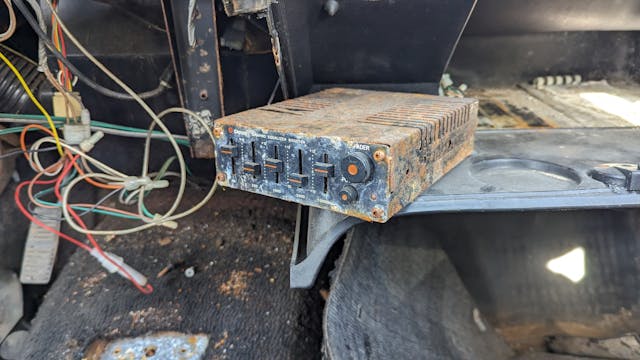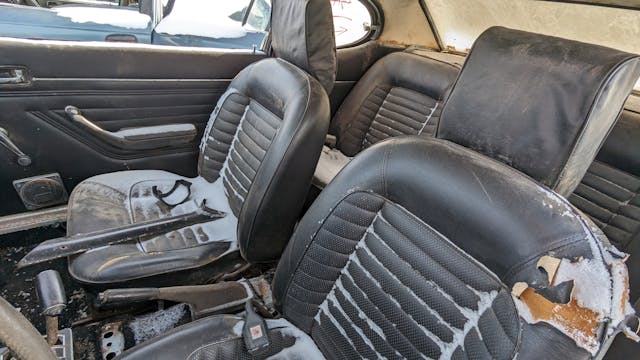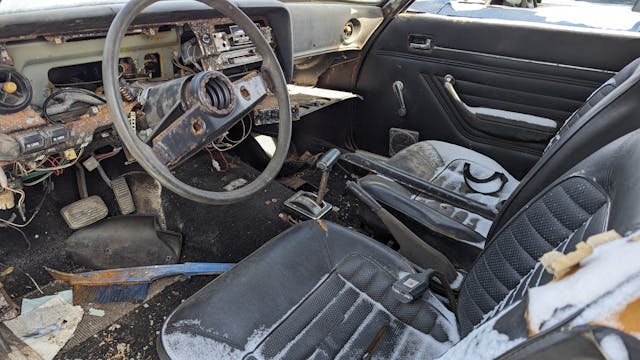Media | Articles
Final Parking Space: 1974 Ford Capri
During the late 1960s through early 1970s, the Detroit car manufacturers made a serious effort to bring over the products made by their operations in Western Europe; though some Vauxhalls and British Fords had been imported in earlier years, they had remained well outside the American automotive mainstream. GM offered various Opel models, Chrysler took a shot at moving Americanized Simca 1100s and Hillman Avengers, and Ford opted to sell its new sporty fastback here. This was the Capri, and I’ve found a snow-dusted first-generation example in a Denver-area car graveyard.

The Capri name has a lengthy history in the Ford Empire, beginning with the Lincoln Cosmopolitan Capri of the early 1950s, but this type of Capri is by far the best known. In the United States, this car was sold through Mercury dealers with no marque badging.

I came of driving age in Northern California in the early 1980s, and at that time everybody I knew referred to these cars—which were still common sights on the roads of the Golden State—as Mercury Capris despite the lack of Mercury badging.

Dearborn began selling Fox-body Mustang twins with Mercury Capri badging for the 1979 model year, with production continuing through 1986. The Mercury Capri name returned for the 1991 through 1994 model years, on an Australian-built two-seat convertible based on the platform of the Mazda 323. Those Capris are by far the easiest to find in American boneyards today.

This type of Capri was sold in the United States for the 1970 through 1977 model years, and most North American owners of these cars prefer to use the European “Ford Capri” designation to avoid confusion with the later, Mercury-badged Capris.
Marketplace
Buy and sell classics with confidence

By the early 1970s, the Mustang had become bigger, heavier, and more luxurious than its mid-1960s predecessors, so it made sense that Ford should offer a lightweight sporty car for Americans who preferred nimble handling and decent fuel economy.

All U.S.-market Ford Capris were built in Cologne, West Germany. For other markets, they were assembled in the United Kingdom, Singapore, Australia, and South Africa.

Capri sales improved each year at first, reaching the 90,000 mark for 1972 and topping 100,000 units sold for 1973. Then Ford introduced a new, smaller Mustang based on a modified Pinto platform for 1974; it was a few hundred pounds heavier than the Capri but also quite a bit cheaper. Capri sales in the United States began a steady decline at that point.

The 1974 Capri had an MSRP of $3566 with four-cylinder engine and four-speed manual transmission, or about $23,601 in 2024 dollars. Meanwhile, the 1974 Mustang II started at just $3081 ($20,391 after inflation).

There were plenty of similarities to be seen in the engine compartments of the Mustang II and its same-year Capri intra-corporate competitors. This car came with a 2.0-liter SOHC straight-four rated at 80 horsepower, while the base engine in the 1974 Mustang II was a 2.3-liter version of the same engine with 85 horses.

Both the Capri and the Mustang II for ’74 could be purchased with the 2.8-liter “Cologne” V-6 as optional equipment. That engine made 105 horsepower in both applications. For 1975, optional V-8 power returned to the Mustang, while the base Capri got the 2.3-liter four-banger.

This car has the optional three-speed automatic transmission, which added $256 to its cost ($1694 in today’s money). I think this is the first 1970–77 Capri I’ve ever seen with an automatic.

It’s not especially rusty, but decades of outdoor storage have taken their toll. The interior is full of rodent nesting material and droppings, a real hantavirus threat in High Plains Colorado.

I think this car hasn’t run under its own power for at least 40 years.

This Clarion equalizer/booster appears to be of early-1980s vintage.

The lack of horrific rust would make this car well worth restoring on the other side of the Atlantic, but it makes more sense as a parts car here.
***
Check out the Hagerty Media homepage so you don’t miss a single story, or better yet, bookmark it. To get our best stories delivered right to your inbox, subscribe to our newsletters.






























































I remember these well, had a friend in high school who had one. Appreciate your column, always interesting and fun to read.
Interesting to note the Rostyle wheels on this Capri. Those wheels are generally associated with MGB’s, but were available on a number of other cars including the Vauxhall VX4 and Land Rover.
Ironically, they were an American wheel design manufactured by the Motor Wheel Corp. in Michigan and were known on vehicles as diverse as the Javelin and Shelby Mustangs, known here as Magnum 500 wheels.
Great car, solid handling, if typically underpowered in that era. The mid-late 70’s were a weird time for German imports. The Dollar was sliding, while the German Mark was going up, almost daily. The exchange rate really killed the value of bringing in German cars, for most of a decade. Plus, the crazy inflation of the late 70’s moved buyers to cheaper Asian imports. Great find, love your research.
My first new car in 1973! Yellow with a V6 and 4 speed. Lots of fun and good times. Sold her when the baby came along five years later. Wish I still had that car today…
As much as I hate the general concept of the LS swap, that car is a prime candidate
I have done LS swaps and love them BUT for a Capri, I’m keen on doing a Ford / Mazda MZR 2.5 swap. Tuned with Burton Power parts to 8000rpm and 250-275hp I think it would be perfect! ITB’s howling and enough power to be much quicker than expected but also low enough to mat the throttle and row the gears. An LS would overwhelm the chassis, brakes etc and would mostly be for bragging and carefully planned and pointed 10 second bursts of full throttle.
I agree 100% . Then the Mazda 5 SPD. Lose the bumpers. Car looks solid. These are getting scarce.
My mom had a brown ‘73 w manual transmission in the late seventies. She didn’t have it very long as it was hard to shift. The next car was on the other end of the spectrum, a white w red leather ‘75 Thunderbrougham.
My first car I picked up for $800 was 1973 Capri with 2.6 and 4 speed. Guy I bought from had lowered it and put Hooker headers with Cherry Bomb mufflers…it sounded awesome
The car was light weight and quick. Wished I’d never let it go and would love to find another but they are very hard to find these days.
Mine was originally yellow but it had been painted white by the time I bought it.
I too had a friend in school that owned a Red Exterior, Tan Interior, Standard Trans. was a fun little car. Of course, for a muscle car guy not enough horsepower or straight-line power, however a decent handler. A 302 Ford small block could cure the horsepower issue real quick.
I test drove one at a Lincoln-Mercury dealer in Jackson, Tn. in the middle 70s. They didn’t even bother to wash the car. I could barely see out of the windshield. Perhaps they were indifferent to them in a relatively rural area. They didn’t compare to the Opel Manta which I eventually bought at the Buick dealer. I drove it 140K miles.
Great article! Took me back to 1977 in high school. Had a sexy Capri V6 manual shift, butterscotch yellow with black strips. Large black “Capri”lettering spelled out along the bottom of each door. It was the coolest sports car there. Life was good…until another guy bought a nice white Datsun 240Z! I then had the 2nd coolest sports car at my school.
Loved the little rear side windows that latched out sideways. Funny what you remember.
Had a V-6 version in the early ’80’s – a handme down from my uncle. The clutch was so heavy my wife couldn’t drive it. It was fine but not a car you wanted to be doing stop and go in traffic. Built up my left leg and moved on….
Rearrange the letters Capri and you have Crapi. Enough said!
Way back in the 80’s I wanted to do it to my friend’s letters on the trunk, but he would have known who did it!
Fun driver with the 1600
The rear side windows commonly fell out.
I looked at a used 74 in the winter of 1976. I would gave bought it except it seems the blower motor for the heat was optional. And this car didn’t have one!
I had a Kent engined 71 1600 (slow but great handling) and still have a 73 2.6 (much quicker).
This one looks remarkably rot free. Great for parts if nothing else.